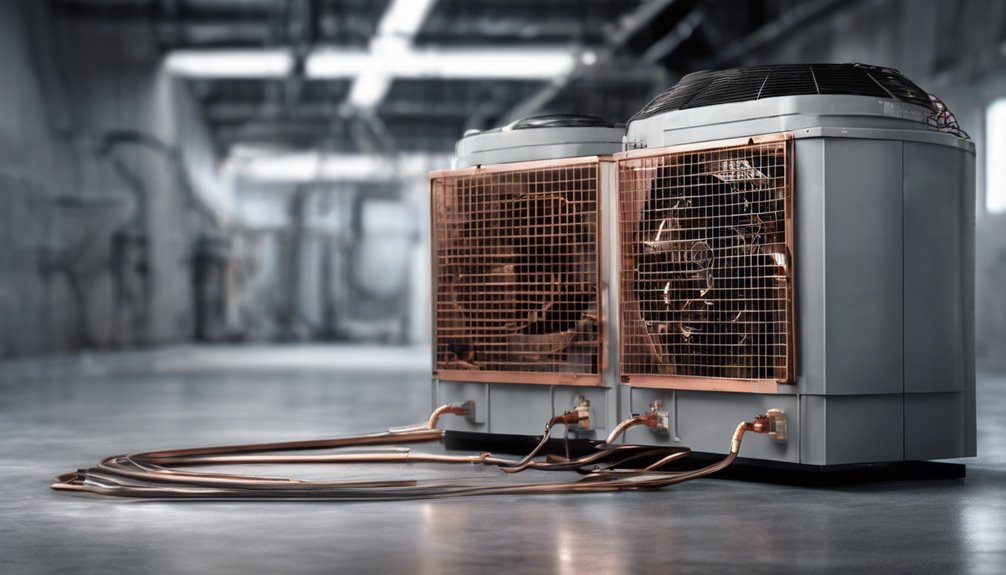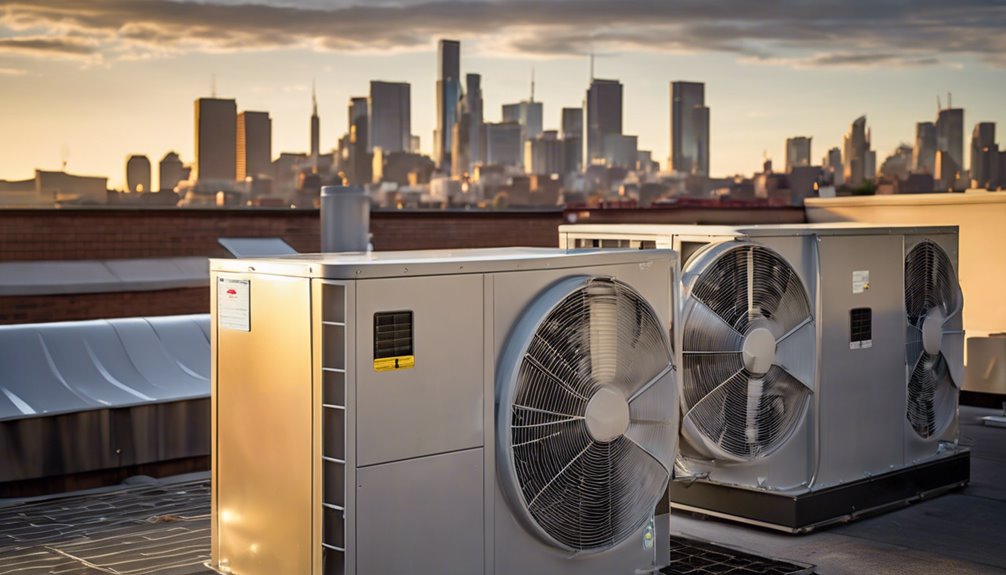When choosing between split AC and window AC services, you're likely weighing factors like energy efficiency, noise levels, and design flexibility. Split ACs offer advanced air purification, smart integration, and sleek designs, but come with higher upfront costs. Window ACs, on the other hand, are more affordable and easy to install, but may obstruct views and have limited control options. As you consider your cooling needs, you'll want to explore these differences further to find the best fit for your space – and the perfect balance of comfort, convenience, and value.
Key Takeaways
- Split ACs offer advanced air purification, smart integration, and energy efficiency, making them a popular choice for homeowners who value comfort and air quality.
- Split ACs provide more flexibility in terms of room layout and design, as the indoor unit can be mounted on any wall, whereas window ACs obstruct views and limit window functionality.
- Split ACs have an energy efficiency edge over window units, with multiple cooling modes to customize the cooling experience and save energy, earning them ENERGY STAR labels.
- Split ACs are generally quieter than window ACs, with average noise levels ranging from 30 to 40 decibels, making them suitable for shared living spaces.
- While window ACs are more affordable upfront, split ACs offer long-term energy savings and a higher level of customization, making them a cost-effective option in the long run.
Key Features of Split ACs
Explore the benefits of split ACs by examining their key features, which set them apart from window ACs.
You'll find that split ACs offer advanced air purification systems, removing allergens and pollutants from the air, providing a healthier indoor environment.
They also come with smart integration features, allowing you to control the temperature, fan speed, and other settings remotely using your smartphone.
This means you can adjust the AC's settings even when you're not in the room.
Additionally, split ACs are designed to be energy-efficient, reducing your energy bills and minimizing their environmental impact.
With their sleek and modern design, split ACs are a popular choice for homeowners who value convenience, comfort, and air quality.
Benefits of Window ACs
While split ACs have their advantages, window ACs offer their own set of benefits that make them a popular choice for many homeowners.
You'll appreciate the air purification feature, which removes pollutants and allergens from the air, providing a healthier breathing environment.
Breathe easy with window ACs, which remove pollutants and allergens for a healthier breathing environment.
Window ACs also come with multiple cooling modes, allowing you to customize your cooling experience. You can choose from energy-saving modes, turbo modes, or silent modes, depending on your needs.
Additionally, window ACs are generally more affordable than split ACs, making them a cost-effective option for many households.
Space and Design Considerations
When it comes to installing an air conditioning unit, the space and design of your home play a significant role in determining which type is best for you.
Consider the layout of your rooms, particularly the corner placement of your furniture. Window ACs are often bulkier and may obstruct your view or limit your window's functionality.
Split ACs, on the other hand, offer more flexibility in terms of furniture arrangement, as the indoor unit can be mounted on any wall, allowing you to make the most of your space.
Additionally, split ACs can be installed in rooms with limited window access, making them a great option for rooms with few or no windows.
Cooling Capacity and Coverage
The cooling capacity and coverage of an air conditioner are crucial factors to consider when choosing between a split AC and a window AC.
You'll want to think about the size of the space you need to cool and the temperature range you're aiming for.
- Imagine a large open-plan living area that requires multiple cooling zones to maintain a consistent temperature.
- Picture a small bedroom that only needs a single zone of cooling to reach a comfortable temperature range of 68-72°F (20-22°C).
- Envision a home office with a lot of heat-generating equipment that requires a higher cooling capacity to keep the space at a cool 65°F (18°C).
- Consider a spacious master bedroom with a temperature range of 70-75°F (21-24°C) that needs multiple zones of cooling.
- Think about a studio apartment that only requires a single zone of cooling to maintain a comfortable temperature range of 72-76°F (22-24°C).
Energy Efficiency and Operating Costs
You've narrowed down your cooling capacity and coverage needs, but now it's time to think about the long-term costs of running your AC.
When it comes to energy efficiency, split ACs generally have an edge over window units. Look for energy labels like ENERGY STAR to ensure you're getting a model that meets energy efficiency standards.
Split ACs have an energy efficiency edge over window units, so look for the ENERGY STAR label to save energy and costs.
Split ACs often have multiple cooling modes, allowing you to customize your cooling experience and save energy. In contrast, window ACs usually have a single cooling mode, which can lead to higher operating costs.
Considering the energy efficiency of your AC can save you money in the long run, so choose wisely. By selecting an energy-efficient model, you'll be comfortable and cost-effective.
Noise Levels and Disturbances
When you're deciding between a split AC and a window AC, you'll want to consider the noise levels and disturbances each unit produces.
You'll likely want to minimize indoor noise reduction, especially if you plan to install the unit in a bedroom or living room.
The outdoor unit's noise is also important, as it can impact your outdoor living space or disturb your neighbors.
Indoor Noise Reduction
Your indoor space deserves to be a sanctuary, so it's essential to consider the noise levels of your air conditioning unit.
When it comes to indoor noise reduction, split ACs have a clear advantage. They're designed for silent operation, with the compressor and fan located in the outdoor unit, leaving only a quiet indoor unit that won't disturb you.
Some benefits of split AC's indoor noise reduction include:
- Whisper-quiet fan operation that won't disrupt your sleep or daily activities
- Active soundproofing that minimizes noise leakage from the outdoor unit
- A peaceful living space that's perfect for relaxation or focus
- Reduced noise pollution that won't disturb your family or neighbors
- Unobtrusive design that blends into your home's décor
Outdoor Unit Noise
How much noise is acceptable outside your home?
When it comes to outdoor unit noise, the answer varies. As an urban dweller, you're likely accustomed to some level of noise pollution.
However, excessive noise from an air conditioner's outdoor unit can be a nuisance. Split ACs tend to be quieter than window ACs, with average noise levels ranging from 30 to 40 decibels.
Window ACs, on the other hand, can produce up to 50 decibels of noise. If you live in an apartment or shared living space, consider a split AC for its reduced outdoor noise.
But if you're looking for a more affordable option and don't mind a bit more noise, a window AC might be the way to go.
Installation and Maintenance Requirements
When considering installation and maintenance requirements, you'll need to think about the space and access needs for each type of AC.
For instance, split ACs typically require more complex installations with outdoor and indoor units, while window ACs are generally simpler to install.
You'll also want to weigh the energy efficiency considerations of each option, as they can impact your utility bills and environmental footprint.
Space and Access Needs
The installation and maintenance of air conditioning units require careful consideration of the space and access needs.
As you weigh the pros and cons of split AC vs. window AC, think about the physical constraints of your space.
Will the unit fit snugly in a corner, or will it jut out into the room?
- Will you need to rearrange furniture to accommodate the unit?
- Are there any corner constraints that might limit installation options?
- Is the space near a window, or will you need to run a longer hose?
- Will the unit's vents or ducts fit through doorways or narrower hallways?
- Are there any obstacles, like curtains or shelves, that might block airflow?
Energy Efficiency Considerations
You're likely considering energy efficiency when choosing between a split AC and a window AC, and rightly so.
Both options have varying energy efficiency ratings, which can significantly impact your utility bills. When evaluating energy efficiency, look for green ratings like the Energy Star label, which indicates that the AC meets energy efficiency standards set by the U.S. Environmental Protection Agency.
Consider your seasonal usage patterns as well. If you only need cooling for a few months, a window AC might be a more efficient choice. However, if you need year-round cooling, a split AC's higher upfront cost might be justified by its long-term energy savings.
Upfront Costs and Long-Term Value
Purchasing an air conditioner often involves weighing upfront costs against long-term value.
When considering a split AC vs. window AC, you'll want to think about the initial investment and how it will impact your wallet over time.
- A higher upfront cost for a split AC might be offset by cost savings on your energy bill each month.
- A window AC might be cheaper to buy initially, but it could increase your energy costs in the long run.
- You might need to replace a window AC more frequently, adding to your overall expense.
A split AC can last for 15-20 years, making it a more cost-effective option in the long run.
Invest in a split AC for long-term savings, with a lifespan of 15-20 years that makes it a cost-effective choice.
Additionally, split ACs often come with a warranty, protecting your investment for years to come.
Flexibility and Customization Options
When it comes to flexibility and customization options, split ACs and window ACs differ significantly.
You'll find that split ACs offer more flexibility in terms of zone control, allowing you to cool specific areas of your home. This means you can direct airflow exactly where you need it, reducing energy waste and saving you money.
Additionally, split ACs provide personalized airflow, letting you adjust the direction and speed of the air to your liking.
In contrast, window ACs are more limited in their customization options, often blowing air in a fixed direction.
If you value flexibility and precision control, a split AC might be the better choice for you.
Suitability for Different Room Types
The type of room you're cooling also plays a significant role in determining which air conditioner is best suited for the job.
You'll want to consider the room's layout, furniture arrangements, and overall design when deciding between a split AC and a window AC.
- A spacious living room with a high ceiling might benefit from a split AC's ability to cool multiple areas simultaneously.
- A cozy bedroom with limited floor space might be better suited for a compact window AC.
- A home office with a lot of heat-generating electronics might require the more powerful cooling of a split AC.
- A studio apartment with an open floor plan might be effectively cooled by a single window AC.
- A room with a lot of windows or sliding glass doors might require a split AC's more targeted cooling.
Frequently Asked Questions
Can I Install a Split AC in a Room With No Exterior Wall?
You can install an AC in a room with no exterior wall, but you'll need interior ventilation to dissipate heat. This might require wall modification, like adding a vent or grill, to ensure proper airflow and system efficiency.
Do Window ACS Have a Dehumidifying Function?
You'll be happy to know that many window ACs come equipped with a dehumidifying function, which helps remove excess moisture from the air, reducing humidity levels. In dehumidifying modes, they can effectively lower humidity, making your space feel cooler and more comfortable.
Can I Use a Window AC in a Room With a Casement Window?
You can install a window AC in a room with a casement window, but you'll need a casement adapter to secure it properly, considering the unique window constraints that don't allow for traditional window AC installation methods.
Are Split ACS More Prone to Refrigerant Leaks?
You're wondering if split ACs are more prone to refrigerant leaks. Honestly, they're not; modern units have advanced leak detection methods. However, certain refrigerant types, like R-410A, are more susceptible to leaks than others, like R-22.
Can I DIY Install a Window AC or Do I Need a Professional?
You're considering DIY installing a window AC, but be aware that you'll face DIY difficulties and installation obstacles, like improper mounting and drainage issues, which can lead to safety hazards and reduced performance, so it's recommended to hire a professional.
Conclusion
You've weighed the pros and cons of split ACs and window ACs, and now it's time to make a decision. Consider your specific needs and priorities. If you value flexibility, energy efficiency, and a sleek design, a split AC might be the way to go. But if you're on a budget and need a quick cooling fix, a window AC could be the better choice. Whatever you decide, you'll be enjoying a cooler, more comfortable space in no time.



